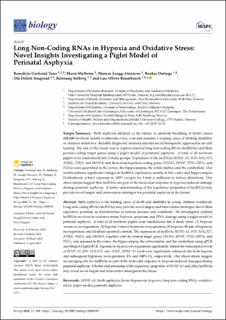Long Non-Coding RNAs in Hypoxia and Oxidative Stress: Novel Insights Investigating a Piglet Model of Perinatal Asphyxia
| dc.contributor.author | Tune, Benedicte Grebstad | |
| dc.contributor.author | Melheim, Maria | |
| dc.contributor.author | Åsegg-Atneosen, Monica | |
| dc.contributor.author | Dotinga, Baukje | |
| dc.contributor.author | Saugstad, Ola Didrik | |
| dc.contributor.author | Solberg, Rønnaug | |
| dc.contributor.author | Baumbusch, Lars Oliver | |
| dc.date.accessioned | 2024-02-07T13:10:10Z | |
| dc.date.available | 2024-02-07T13:10:10Z | |
| dc.date.created | 2023-04-18T13:30:04Z | |
| dc.date.issued | 2023 | |
| dc.identifier.citation | Biology. 2023, 12 (4), Artikkel 549. | en_US |
| dc.identifier.issn | 2079-7737 | |
| dc.identifier.uri | https://hdl.handle.net/11250/3116189 | |
| dc.description.abstract | Birth asphyxia is the leading cause of death and disability in young children worldwide. Long non-coding RNAs (lncRNAs) may provide novel targets and intervention strategies due to their regulatory potential, as demonstrated in various diseases and conditions. We investigated cardinal lncRNAs involved in oxidative stress, hypoxia, apoptosis, and DNA damage using a piglet model of perinatal asphyxia. A total of 42 newborn piglets were randomized into 4 study arms: (1) hypoxia –normoxic reoxygenation, (2) hypoxia–3 min of hyperoxic reoxygenation, (3) hypoxia–30 min of hyperoxic reoxygenation, and (4) sham-operated controls. The expression of lncRNAs BDNF-AS, H19, MALAT1, ANRIL, TUG1, and PANDA, together with the related target genes VEGFA, BDNF, TP53, HIF1α, and TNFα, was assessed in the cortex, the hippocampus, the white matter, and the cerebellum using qPCR and Droplet Digital PCR. Exposure to hypoxia–reoxygenation significantly altered the transcription levels of BDNF-AS, H19, MALAT1, and ANRIL. BDNF-AS levels were significantly enhanced after both hypoxia and subsequent hyperoxic reoxygenation, 8% and 100% O2, respectively. Our observations suggest an emerging role for lncRNAs as part of the molecular response to hypoxia-induced damages during perinatal asphyxia. A better understanding of the regulatory properties of BDNF-AS and other lncRNAs may reveal novel targets and intervention strategies in the future. | en_US |
| dc.language.iso | eng | en_US |
| dc.publisher | MDPI | en_US |
| dc.rights | Navngivelse 4.0 Internasjonal | * |
| dc.rights.uri | http://creativecommons.org/licenses/by/4.0/deed.no | * |
| dc.subject | BDNF-AS | en_US |
| dc.subject | birth asphyxia | en_US |
| dc.subject | brain | en_US |
| dc.subject | hyperoxia | en_US |
| dc.subject | hypoxia | en_US |
| dc.subject | long non-coding RNA | en_US |
| dc.subject | oxidative stress | en_US |
| dc.subject | piglet model | en_US |
| dc.subject | perinatal asphyxia | en_US |
| dc.title | Long Non-Coding RNAs in Hypoxia and Oxidative Stress: Novel Insights Investigating a Piglet Model of Perinatal Asphyxia | en_US |
| dc.type | Peer reviewed | en_US |
| dc.type | Journal article | en_US |
| dc.description.version | publishedVersion | en_US |
| dc.rights.holder | © 2023 by the authors. | en_US |
| dc.subject.nsi | VDP::Medisinske Fag: 700::Klinisk medisinske fag: 750 | en_US |
| dc.source.volume | 12 | en_US |
| dc.source.journal | Biology | en_US |
| dc.source.issue | 4 | en_US |
| dc.identifier.doi | 10.3390/biology12040549 | |
| dc.identifier.cristin | 2141610 | |
| dc.source.articlenumber | 549 | en_US |
| cristin.ispublished | true | |
| cristin.fulltext | original | |
| cristin.qualitycode | 1 |

